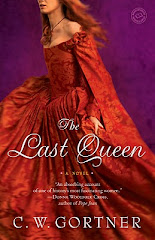Wow! It seems as if this year went by really fast. I can't believe it's almost 2012. Looking back, however, I realize this is because it was such a jam-packed year for me, one I've been lucky to share with many of you. Here are some of the highlights:
February 2011 saw the publication of THE TUDOR SECRET, the first novel in my Elizabeth I Spymaster Chronicles - a wonderful achievement for me, as this is my little-novel-that-could. After years of rejection, I decided to independently publish this novel as The Secret
 Lion. That version's success helped me regain the confidence that the bruising cycle of submission and rejection had sapped; more importantly, it eventually gained me the attention I needed to catch my agent's eye. In an ironic twist of fate, it was sold, along with the next two in the series, to the same editor who read my very first novel, submitted by my very first agent, 13 years previously. All in all, proof that persistence is everything. To date, THE TUDOR SECRET has been sold in 7 countries and is poised for a massive bestseller campaign in Italy in February, 2012. Apparently, February is turning out to be a good luck month for me!
Lion. That version's success helped me regain the confidence that the bruising cycle of submission and rejection had sapped; more importantly, it eventually gained me the attention I needed to catch my agent's eye. In an ironic twist of fate, it was sold, along with the next two in the series, to the same editor who read my very first novel, submitted by my very first agent, 13 years previously. All in all, proof that persistence is everything. To date, THE TUDOR SECRET has been sold in 7 countries and is poised for a massive bestseller campaign in Italy in February, 2012. Apparently, February is turning out to be a good luck month for me!May 2011 saw publication of the paperback edition of THE CONFESSIONS OF CATHERINE DE MEDICI, another novel that underwent a long period of gestation, challenge, and change. From its original 798 pages, it was edited down during various submissions before it finally found its home, and transformed in the process from an epic recounting of 16th century France under Catherine's reign into a far more intimate story of this often vilified and misunderstood woman. The hardcover edition made several Top Reads of 2010 lists and sold out; I like to think that wherever Catherine is today, she's smiling :)
June 2011 brought the gathering of the historical fiction tribe in San Diego for the 4th US Historical Novel Society Conference. Beside the sparkling bay, readers, writers, bloggers, and fans of the genre congregated for two and a half days of panels, dinners and lunches, impromptu meetings, outings
 , and much laughter and celebration. Some of the highlights for me were lunch with my fellow authors of the Jean V. Naggar Literary Agency; C.C. Humphreys in blue velvet, playing the libidinous earl of Rochester in the late-night sex scene reading from Gillian Bagwell's The Darling Strumpet; seeing my agent at the podium, receiving the accolade she so richly deserves for all of her and the agency's hard work representing some of our genre's most celebrated authors; drinking wine with my editor; sharing time on panels with fellow authors, and of course fun with friends.
, and much laughter and celebration. Some of the highlights for me were lunch with my fellow authors of the Jean V. Naggar Literary Agency; C.C. Humphreys in blue velvet, playing the libidinous earl of Rochester in the late-night sex scene reading from Gillian Bagwell's The Darling Strumpet; seeing my agent at the podium, receiving the accolade she so richly deserves for all of her and the agency's hard work representing some of our genre's most celebrated authors; drinking wine with my editor; sharing time on panels with fellow authors, and of course fun with friends.July through September saw me hard at work on THE QUEEN'S VOW, my novel about Isabella of Castile, which will be published on June 12, 2012. I loved returning to early
 Renaissance Spain and re-discovering Isabella, who'd played such a significant supporting role in my first book, The Last Queen. One of my continuing joys in writing historical fiction is recognizing my own prejudices and preconceived notions, and seeing how my research has influenced these beliefs. Like Catherine de Medici and Juana la Loca (who was Isabella's daughter) Isabella of Castile has suffered from history's verdict, her reign one of great accomplishment but also dark controversy. I hope this novel about her early years and tumultuous rise to the throne, as well as her struggles as a young bride and queen, will help to humanize her for readers. For in the end, that is what historical fiction does best: it helps us to see these long-gone characters from the past as people, first and foremost.
Renaissance Spain and re-discovering Isabella, who'd played such a significant supporting role in my first book, The Last Queen. One of my continuing joys in writing historical fiction is recognizing my own prejudices and preconceived notions, and seeing how my research has influenced these beliefs. Like Catherine de Medici and Juana la Loca (who was Isabella's daughter) Isabella of Castile has suffered from history's verdict, her reign one of great accomplishment but also dark controversy. I hope this novel about her early years and tumultuous rise to the throne, as well as her struggles as a young bride and queen, will help to humanize her for readers. For in the end, that is what historical fiction does best: it helps us to see these long-gone characters from the past as people, first and foremost.As the year comes to a close, I'm currently at work on the editorial revision of my second Spymaster book, tentatively titled The Tudor Deception. I plan to finish the revision by the start of 2012 and then turn my full attention to my next stand-alone novel, Borgia's Daughter, about the early years of another infamous woman I find fascinating: Lucrezia Borgia.
It's been an incredibly busy and productive year, one which certainly could not have been possible without your ongoing support. Every reader who bought my book; every book club who invited me to chat; every blogger who reviewed my work, interviewed me, or posted a guest post; every recommendation, criticism, or mention - these are integral to my success. I owe it all to you and I want to extend my most heartfelt appreciation.
I wish you all a very happy holiday season, filled with health and love. May we find better ways to live together as a community; to treat our fellow beings, animal and human, with love and respect; to find peace and restore harmony to our much beleaguered planet.
And may we always tell and read stories, for story is the universal tie that binds us.










































